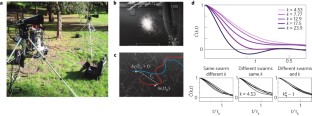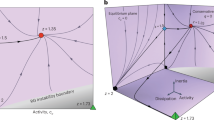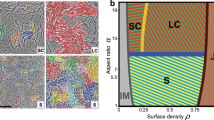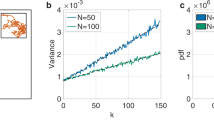Abstract
Collective behaviour in biological systems presents theoretical challenges beyond the borders of classical statistical physics. The lack of concepts such as scaling and renormalization is particularly problematic, as it forces us to negotiate details whose relevance is often hard to assess. In an attempt to improve this situation, we present here experimental evidence of the emergence of dynamic scaling laws in natural swarms of midges. We find that spatio-temporal correlation functions in different swarms can be rescaled by using a single characteristic time, which grows with the correlation length with a dynamical critical exponent z ≈ 1, a value not found in any other standard statistical model. To check whether out-of-equilibrium effects may be responsible for this anomalous exponent, we run simulations of the simplest model of self-propelled particles and find z ≈ 2, suggesting that natural swarms belong to a novel dynamic universality class. This conclusion is strengthened by experimental evidence of the presence of non-dissipative modes in the relaxation, indicating that previously overlooked inertial effects are needed to describe swarm dynamics. The absence of a purely dissipative regime suggests that natural swarms undergo a near-critical censorship of hydrodynamics.
This is a preview of subscription content, access via your institution
Access options
Access Nature and 54 other Nature Portfolio journals
Get Nature+, our best-value online-access subscription
$29.99 / 30 days
cancel any time
Subscribe to this journal
Receive 12 print issues and online access
$209.00 per year
only $17.42 per issue
Buy this article
- Purchase on Springer Link
- Instant access to full article PDF
Prices may be subject to local taxes which are calculated during checkout



Similar content being viewed by others
References
Widom, B. Equation of state in the neighborhood of the critical point. J. Chem. Phys. 43, 3898–3905 (1965).
Kadanoff, L. The introduction of the idea that exponents could be derived from real-space scaling arguments. Physics 2, 263–273 (1966).
Ferrell, R. A., Menyhárd, N., Schmidt, H., Schwabl, F. & Szépfalusy, P. Dispersion in second sound and anomalous heat conduction at the lambda point of liquid helium. Phys. Rev. Lett. 18, 891–894 (1967).
Halperin, B. I. & Hohenberg, P. C. Generalization of scaling laws to dynamical properties of a system near its critical point. Phys. Rev. Lett. 19, 700–703 (1967).
Wilson, K. G. Renormalization group and critical phenomena. I. Renormalization group and the Kadanoff scaling picture. Phys. Rev. B 4, 3174–3183 (1971).
Wilson, K. G. Renormalization group and strong interactions. Phys. Rev. D 3, 1818–1846 (1971).
Attanasi, A. et al. Collective behaviour without collective order in wild swarms of midges. PLoS Comput. Biol. 10, e1003697 (2014).
Cavagna, A. et al. Scale-free correlations in starling flocks. Proc. Natl Acad. Sci. USA 107, 11865–11870 (2010).
Strandburg-Peshkin, A. et al. Visual sensory networks and effective information transfer in animal groups. Curr. Biol. 23, R709–R711 (2013).
Ginelli, F. et al. Intermittent collective dynamics emerge from conflicting imperatives in sheep herds. Proc. Natl Acad. Sci. USA 112, 12729–12734 (2015).
Dombrowski, C., Cisneros, L., Chatkaew, S., Goldstein, R. E. & Kessler, J. O. Self-concentration and large-scale coherence in bacterial dynamics. Phys. Rev. Lett. 93, 098103 (2004).
Zhang, H.-P., Beer, A., Florin, E.-L. & Swinney, H. L. Collective motion and density fluctuations in bacterial colonies. Proc. Natl Acad. Sci. USA 107, 13626–13630 (2010).
Tang, Q.-Y., Zhang, Y.-Y., Wang, J., Wang, W. & Chialvo, D. R. Critical fluctuations in the native state of proteins. Phys. Rev. Lett. 118, 088102 (2017).
Attanasi, A. et al. Greta-a novel global and recursive tracking algorithm in three dimensions. IEEE Trans. Pattern Anal. Mach. Intell. 37, 2451–2463 (2015).
Okubo, A., Bray, D. & Chiang, H. Use of shadows for studying the three-dimensional structure of insect swarms. Ann. Entomol. Soc. Am. 74, 48–50 (1981).
Gibson, G. Swarming behaviour of the mosquito Culex pipiens quinquefasciatus: a quantitative analysis. Physiol. Entomol. 10, 283–296 (1985).
Ikawa, T., Okabe, H., Mori, T., Urabe, K.-i. & Ikeshoji, T. A method for reconstructing three-dimensional positions of swarming mosquitoes. J. Insect Behav. 7, 237–248 (1994).
Kelley, D. H. & Ouellette, N. T. Emergent dynamics of laboratory insect swarms. Sci. Rep. 3, 1073 (2013).
Puckett, J. G., Kelley, D. H. & Ouellette, N. T. Searching for effective forces in laboratory insect swarms. Sci. Rep. 4, 4766 (2014).
Butail, S. et al. 3D tracking of mating events in wild swarms of the malaria mosquito Anopheles gambiae. 2011 Annual International Conference of the IEEE Engineering in Medicine and Biology Society 720–723 (IEEE, 2011).
Butail, S. et al. Reconstructing the flight kinematics of swarming and mating in wild mosquitoes. J. R. Soc. Interface 9, 2624–2638 (2012).
Attanasi, A. et al. Finite-size scaling as a way to probe near-criticality in natural swarms. Phys. Rev. Lett. 113, 238102 (2014).
Puckett, J. G., Ni, R. & Ouellette, N. T. Time-frequency analysis reveals pairwise interactions in insect swarms. Phys. Rev. Lett. 114, 258103 (2015).
Ni, R., Puckett, J. G., Dufresne, E. R. & Ouellette, N. T. Intrinsic fluctuations and driven response of insect swarms. Phys. Rev. Lett. 115, 118104 (2015).
Ferrell, R., Menyhrd, N., Schmidt, H., Schwabl, F. & Szpfalusy, P. Fluctuations and lambda phase transition in liquid helium. Ann. Phys. 47, 565–613 (1968).
Halperin, B. I. & Hohenberg, P. C. Scaling laws for dynamic critical phenomena. Phys. Rev. 177, 952–971 (1969).
Hohenberg, P. C. & Halperin, B. I. Theory of dynamic critical phenomena. Rev. Mod. Phys. 49, 435–479 (1977).
Kibble, T. W. Topology of cosmic domains and strings. J. Phys. A: Math. Gen. 9, 1387–1398 (1976).
Zurek, W. H. Cosmological experiments in superfluid helium? Nature 317, 505–508 (1985).
Vicsek, T., Czirók, A., Ben-Jacob, E., Cohen, I. & Shochet, O. Novel type of phase transition in a system of self-driven particles. Phys. Rev. Lett. 75, 1226–1229 (1995).
Grégoire, G. & Chaté, H. Onset of collective and cohesive motion. Phys. Rev. Lett. 92, 025702 (2004).
Baglietto, G. & Albano, E. V. Finite-size scaling analysis and dynamic study of the critical behavior of a model for the collective displacement of self-driven individuals. Phys. Rev. E 78, 021125 (2008).
Baglietto, G. & Albano, E. V. Nature of the order-disorder transition in the Vicsek model for the collective motion of self-propelled particles. Phys. Rev. E 80, 050103 (2009).
Couzin, I. D., Krause, J., James, R., Ruxton, G. D. & Franks, N. R. Collective memory and spatial sorting in animal groups. J. Theor. Biol. 218, 1–11 (2002).
Chaté, H., Ginelli, F., Grégoire, G., Peruani, F. & Raynaud, F. Modeling collective motion: variations on the Vicsek model. Eur. Phys. J. B 64, 451–456 (2008).
Toner, J. & Tu, Y. Long-range order in a two-dimensional dynamical xy model: how birds fly together. Phys. Rev. Lett. 75, 4326–4329 (1995).
Toner, J. & Tu, Y. Flocks, herds, and schools: a quantitative theory of flocking. Phys. Rev. E 58, 4828–4858 (1998).
Kyriakopoulos, N., Ginelli, F. & Toner, J. Leading birds by their beaks: the response of flocks to external perturbations. New J. Phys. 18, 073039 (2016).
Forster, D. Hydrodynamic fluctuations, broken symmetry, and correlation functions. Frontiers in Physics Vol. 47343 (WA Benjamin, Inc., 1975).
Chaikin, P. & Lubensky, T. Principles of Condensed Matter Physics (Cambridge Univ. Press, 2000).
Attanasi, A. et al. Information transfer and behavioural inertia in starling flocks. Nat. Phys. 10, 691–696 (2014).
Gorbonos, D. et al. Long-range acoustic interactions in insect swarms: an adaptive gravity model. New J. Phys. 18, 073042 (2016).
Marshall, W. Critical scattering of neutrons by ferromagnets. Natl. Bur. Std. (U. S.) Misc. Publ. 273, 135–142 (1966).
Marshall, W. & Lowde, R. Magnetic correlations and neutron scattering. Rep. Prog. Phys. 31, 705–775 (1968).
Mora, T. & Bialek, W. Are biological systems poised at criticality? J. Stat. Phys. 144, 268–302 (2011).
Cavagna, A. et al. Spatio-temporal correlations in models of collective motion ruled by different dynamical laws. Phys. Biol. 13, 065001 (2016).
Acknowledgements
We thank S. Caprara, F. Cecconi, F. Ginelli and J. G. Lorenzana for important discussions. This work was supported by IIT-Seed Artswarm, European Research Council Starting Grant 257126, US Air Force Office of Scientific Research Grant FA95501010250 (through the University of Maryland) and ERANET-LAC grant CRIB. T.S.G. was supported by grants from CONICET, ANPCyT and UNLP (Argentina).
Author information
Authors and Affiliations
Contributions
A.C. and I.G. designed the study. S.M. coordinated the experiment. C.C., L.D.C. and S.M. performed the experiment. L.P. and S.M. adapted the tracking algorithm and produced the 3D trajectories. S.M. and D.C. calculated the experimental correlation functions. T.S.G. wrote the code and ran the numerical simulations. A.C., D.C., I.G., T.S.G., S.M. and M.V. performed the theoretical analysis. A.C. wrote the paper.
Corresponding authors
Ethics declarations
Competing interests
The authors declare no competing financial interests.
Supplementary information
Supplementary information
Supplementary information (PDF 390 kb)
Rights and permissions
About this article
Cite this article
Cavagna, A., Conti, D., Creato, C. et al. Dynamic scaling in natural swarms. Nature Phys 13, 914–918 (2017). https://doi.org/10.1038/nphys4153
Received:
Accepted:
Published:
Issue Date:
DOI: https://doi.org/10.1038/nphys4153



